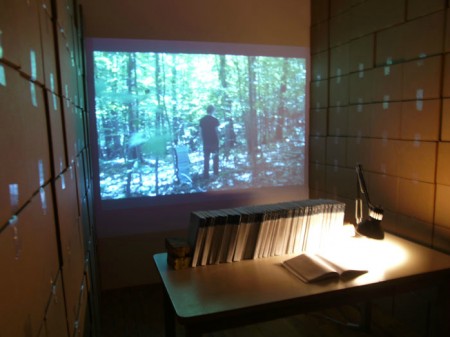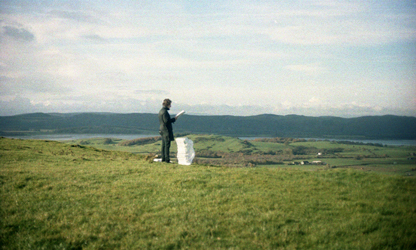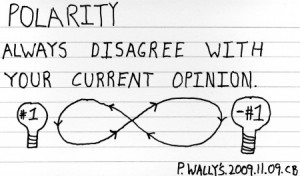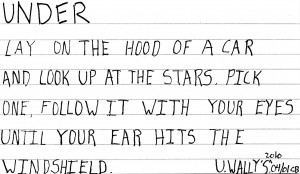Collaborative duo Cupola Bobber, comprised of Stephen Fiehn and Tyler Myers, work slowly. When the SAIC graduates, who have worked almost exclusively in performance until this year, first chose to make work together, they decided to spend two years on every project. Those of us who live in Chicago during the decade they showed the resulting full-length performances here were privy to their attentive, obsessive, matchlessly substantive explorations of the night sky and railroads, the mythology of the sea and dust bowls, and the infinite space of libraries. This last subject, taken up by 2011’s The Field, The Mantel performance, is also explored in the ongoing projects seen in Cupola Bobber’s current exhibition at the independent art space ADDS/DONNA; in the meantime, the duo moved to New York (they were offered a residency at the Manhattan Cultural Council for this spring).
Since their move, Cupola Bobber have begun a number of interrelated and massively formidable projects that require indefatigabile persistence–even for them. For The Dictionary of Endurative Actions, in which they plan to record an endurative action written by hand on index cards by friends and strangers (anyone can contribute) for every word on dictionary.com, the first question they asked themselves was “What tree should we grow?”– that is, the tree to get the wood to build a 24-drawer card catalogue-desk to house the cards. The temporary home of the dictionary is displayed in the ADDS/DONNA show, where visitors are encouraged to provide definitions and new words.
Part of the exhibit also documents the artists’ search for a real sugar maple seed in Central Park (“It’s one of the densest and hardest woods,” Myers explains) for the final desk, along with a number of sculptural “prototyped desks” they made inside ADDS/DONNA’s West Garfield Park gallery space out of found materials. These pieces, the first sculptures that Cupola Bobber has exhibited, are comic studies in early failure–another major theme that recurs in their work.
Cupola Bobber has another, equally epic project unfolding simultaneously. They’ve already recorded eighteen hours of the self-descriptive Reading the Library of Congress Classification Schedule to Nature project (they trade the lists of volumes of classification systems, read in a careful monotone, every hour while filming) but still have hundreds of hours to go. The Library of Congress Classification (LCC) divides all human knowledge into twenty-one categories, each identified by a letter of the alphabet; it’s currently the most prevalent system of its kind in academic libraries across the world. Each of these schedules are subdivided into hundreds of headings, subheadings, and sometimes explanatory text. The final length of the video project will be over two hundred and fifty hours.
At ADDS/DONNA, they’ve turned half the gallery space into a partitioned viewing room (small cardboard boxes, making further references to archives, make up the walls) that contains footage of Fiehn and Myers reading text from stacks of the official American way to categorize the world to a forest of indifferent trees.
The experience of watching–and of flipping through the Catalogs on a makeshift desk–is transfixing, and also utterly exhausting. For the first few minutes, the performance is very funny: two human beings explaining the organization of life and culture to nature itself illuminates our obsession with categorizing and attempting to control the real. Soon after, watching becomes merely sad; is the extent of human knowledge our futile attempts to put the world in order? The installation seems to push beyond an embodiment of the “educational turn” in curatorial work and into a kind of aesthetics of pure information: grappling with it, attempting to order it, fighting entropy while creating more noise.

Installation view, "Reading the Library of Congress Classification Schedule to Nature," 2010 - ongoing. Video, 18 hours.
When Fiehn wryly notes that they’ve barely scratched the surface of the categorization lists to be read, I ask him how difficult this work is. “Well, standing in one place for a very long time is difficult,” he explains, “and it’s surprising how physically difficult it is to pronounce words in languages you don’t know.” They hope to capture different environments and seasonal changes in the films to come. The conception of “natural time” is important to the duo, who are interested in time-scales that both take up an endurance of the everyday, and reflect the order of magnitude that time takes outside of human life and experience.
The aesthetics of perseverance have always marked Cupola Bobber’s work (motions repeated to the point of physical exhaustion is a mainstay of their performances), but I wanted to talk to them about their turn to work that requires such monumental investments of time (and in new mediums). I spoke with Fiehn and Myers about their new approaches to asking questions and ordering the world.
Monica Westin: Simply trying to imagine taking on these projects makes me feel anxious and overwhelmed. How do you frame these undertakings, particularly in this gallery setting where the work is nowhere near finished?
Tyler Myers: Well, ever since we’ve been working together in those two-year processes, we haven’t been interested in what the finish would feel or look like, necessarily. It’s liberating to take real time and play in ideas. We’re trying to explore and develop the idea that there is joy in the activity–joy doesn’t come from having finished something.
MW: Is there a politics as well as an aesthetics to considering endurance?
Stephen Fiehn: Working this way came from wanting to spend time. It’s rare you start out that way with anything. There’s the cliche that “it doesn’t pay,” which in itself you might call political.
TM:Endurance is closely related to work. What we hope we are doing is showing both the ability and the courage to endure as well as the struggle of enduring itself. Too often in art contexts you get the [Marina] Abramović version of endurance as the pain of the artist. We’re interested in showing more dynamism and potential than that.
MW: What have you learned in the process?
SF: How hard it is to pronounce words! I spend a lot of time really staring at words, which starts to make language seem extremely bizarre, especially when you’re reading to nature. We’re reading things that were never meant to be read out loud.
TM: I’ve developed an intonation for the organization; each entry has a heading, a subheading, an aside. Getting back to politics, I’m interested in the way archives try to encounter things in a world antagonistic to them–how an archive deals with that by excluding or incorporating the thing. In the filmed, read performance, we’re bringing out an archive that includes antagonism of a good politics…. Oh, and I’ve learned how many times certain stock phrases are used in the Classification Schedule.
SF: Other languages A to Z….
TM: “English, German, other languages…” Often those are the two languages listed–what they consider important. That repeats over and over.
SF: One irony is that of all the books we managed to buy from the Library of Congress, the Fine Art Volume is missing in the collection we have.
The Field, The Mantel (Exhibition) is on view at ADDS/DONNA, 4223 W. Lake, Chicago, IL, from February 5 to March 11, 2012.
Cupola Bobber is a collaboration between Stephen Fiehn and Tyler B. Myers. Founded in 2000, they have created four evening length performances, working slowly out of their studio on the west side of Chicago. They have performed in multiple venues in Chicago, in Portland and New York, and toured internationally. Alongside the evening-length performance work they have made video, durational performance, and published writing. They have been MacDowell Colony fellows, ACE International Fellows at the Nuffield Theatre, Lancaster University, they have served as visiting artists for SAIC’s First Year Program and Goat Island’s Summer School, and have conducted collaborative performance devising workshops for participants of all stripes. Way Out West, the Sea Whispered Me was commissioned by PS122 in NYC, Links Hall in Chicago, and the National Performance Network. Petitmal received a Best of PAC/edge award, and they won a pair of Nelson Raymond Fellowships from The School of the Art Institute with their BFA’s in 2001. The current show The Field, The Mantel, their fifth, is a commission of the Schillertage Festival at the National theatre Mannheim.








Pingback: The MCA’s “This Will Have Been” and the Subjectivity of History | Art21 Blog
Pingback: Microscripts and Visual Conversations: “In the Spirit of Robert Walser” at Donald Young Gallery | Art21 Blog